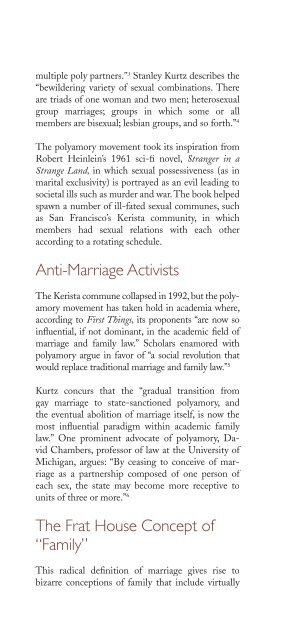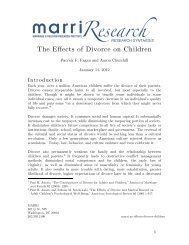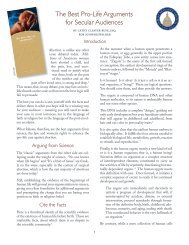The Slippery Slope of Same-Sex Marriage - Family Research Council
The Slippery Slope of Same-Sex Marriage - Family Research Council
The Slippery Slope of Same-Sex Marriage - Family Research Council
You also want an ePaper? Increase the reach of your titles
YUMPU automatically turns print PDFs into web optimized ePapers that Google loves.
multiple poly partners.” 3 Stanley Kurtz describes the<br />
“bewildering variety <strong>of</strong> sexual combinations. <strong>The</strong>re<br />
are triads <strong>of</strong> one woman and two men; heterosexual<br />
group marriages; groups in which some or all<br />
members are bisexual; lesbian groups, and so forth.” 4<br />
<strong>The</strong> polyamory movement took its inspiration from<br />
Robert Heinlein’s 1961 sci-fi novel, Stranger in a<br />
Strange Land, in which sexual possessiveness (as in<br />
marital exclusivity) is portrayed as an evil leading to<br />
societal ills such as murder and war. <strong>The</strong> book helped<br />
spawn a number <strong>of</strong> ill-fated sexual communes, such<br />
as San Francisco’s Kerista community, in which<br />
members had sexual relations with each other<br />
according to a rotating schedule.<br />
Anti-<strong>Marriage</strong> Activists<br />
<strong>The</strong> Kerista commune collapsed in 1992, but the polyamory<br />
movement has taken hold in academia where,<br />
according to First Things, its proponents “are now so<br />
infl uential, if not dominant, in the academic fi eld <strong>of</strong><br />
marriage and family law.” Scholars enamored with<br />
polyamory argue in favor <strong>of</strong> “a social revolution that<br />
would replace traditional marriage and family law.” 5<br />
Kurtz concurs that the “gradual transition from<br />
gay marriage to state-sanctioned polyamory, and<br />
the eventual abolition <strong>of</strong> marriage itself, is now the<br />
most infl uential paradigm within academic family<br />
law.” One prominent advocate <strong>of</strong> polyamory, David<br />
Chambers, pr<strong>of</strong>essor <strong>of</strong> law at the University <strong>of</strong><br />
Michigan, argues: “By ceasing to conceive <strong>of</strong> marriage<br />
as a partnership composed <strong>of</strong> one person <strong>of</strong><br />
each sex, the state may become more receptive to<br />
units <strong>of</strong> three or more.” 6<br />
<strong>The</strong> Frat House Concept <strong>of</strong><br />
“<strong>Family</strong>”<br />
This radical defi nition <strong>of</strong> marriage gives rise to<br />
bizarre conceptions <strong>of</strong> family that include virtually<br />
any relationship or social group. In 1990, a San<br />
Francisco task force on family policy led by lesbian<br />
activist Roberta Achtenberg defi ned the family as<br />
a “unit <strong>of</strong> interdependent and interacting persons,<br />
related together over time by strong social and<br />
emotional bonds and/or by ties <strong>of</strong> marriage, birth,<br />
and adoption.” 7<br />
<strong>The</strong> “frat house with revolving bedroom<br />
doors” concept <strong>of</strong> marriage and the family<br />
poses dangers to children.<br />
Polyamory advocates pay scant attention to the<br />
dangers posed to children being raised according<br />
to this “frat house with revolving bedroom doors”<br />
concept <strong>of</strong> marriage and the family. Yet, this<br />
nebulous, free-for-all model <strong>of</strong> the family looms<br />
ahead for our society unless a bulwark is created in<br />
the form <strong>of</strong> a constitutional amendment protecting<br />
marriage.<br />
<strong>The</strong> slippery slope leading to the destruction <strong>of</strong> marriage<br />
as we know it draws ever closer with the decision<br />
<strong>of</strong> the Massachusetts Supreme Judicial Court<br />
to compel the state legislature to grant homosexual<br />
sex partners the legal status <strong>of</strong> married people. This<br />
decision has emboldened public <strong>of</strong>fi cials in various<br />
localities to grant marriage licenses to homosexual<br />
couples, igniting a national debate on the question:<br />
What is marriage—and where do we draw the limits<br />
on who can marry?




